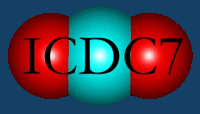Conference Announcement and Overview
September 25th-30th, 2005
Summary:
Since 1981, the
international community of carbon dioxide research scientists has
held a Carbon Dioxide Conference every four years. The word carbon
has become synonymous with climate, generating substantial interest
across broad fields of science, technology and policy. At the 6th
conference held in Sendai, Japan in 2001 (about 300 attendees
compared to about 40 at Bern, Switzerland in 1981) it was decided
that the 7th conference in 2005 would be held in the U.S.
(for the first time) and be organized by NOAA/CMDL.
Areas of interest include
atmospheric monitoring networks, ocean measurements, terrestrial
ecosystems and fluxnets, carbon cycle process models in all of these
settings, inverse transport models that infer surface source/sink
patterns from the observations, new observational techniques, and the
ice core record. New areas will be carbon sequestration (both
natural and engineered) and human dimensions such as fossil fuel use
and land-use decisions. In the past, a special issue of a
peer-reviewed scientific journal has been dedicated to a sub-set of
papers based on oral presentations and posters presented at the
conferences. Guest Editors will be chosen to continue this
tradition.
The main sponsors of the
conference will be the World Meteorological Organization (WMO),
DOC/NOAA/OAR, and the U.S. Carbon Cycle Interagency Working Group,
which is comprised of members of U.S. Federal agencies including DOE,
NASA, NOAA, NSF, USDA, and USGS.
Background:
The implications of the observed
increase in concentration of atmospheric carbon dioxide for global
climate change, and the inherently international scope of the
associated scientific and public policy issues, have led to a series
of international scientific meetings to gain a better understanding
of the global carbon cycle. Beginning in 1981, the international
community of carbon dioxide research scientists has held a Carbon
Dioxide Conference every four years. The first meeting in Bern,
Switzerland, called the "Bern Carbon Dioxide Symposium",
focused primarily on atmospheric measurements of carbon dioxide and
related species. In subsequent meetings (Kandersteg, Switzerland
1985, Hinterzarten, Germany 1989, Carqueiranne, France 1993, Cairns,
Australia 1997, and Sendai, Japan 2001) attention has been focused on
obtaining a better understanding of the global carbon cycle.
ICDC7 will be the first of this series
of conferences to be convened in the United States. An estimated 500
participants are expected. The attendance at the sixth conference,
held in Sendai, Japan in October of 2001 was approximately 300
participants. Many scientists did not attend the Sendai conference
due to travel restrictions and concerns following the September 11,
2001 attacks on the World Trade Center and the Pentagon.
Conference
Objective:
The purpose of this conference is to
bring together scientists from varied disciplines to assess the
current state of knowledge, identify gaps in understanding, and
communicate the most recent results pertinent to the global carbon
cycle, with an emphasis on understanding the contemporary increase of
atmospheric carbon dioxide. Topics will include atmospheric and
oceanic measurements and monitoring networks (including all species
that provide insight into the carbon cycle), terrestrial ecosystems
and land use change, carbon cycle process models, source/sink inverse
models, the ice core record of carbon dioxide and methane, new
observational techniques, long-term potentials and vulnerabilities of
carbon sequestration, and the human impact on the carbon cycle.
Copyright © by The 7th International CO2 Conference Web Site All Right Reserved.










